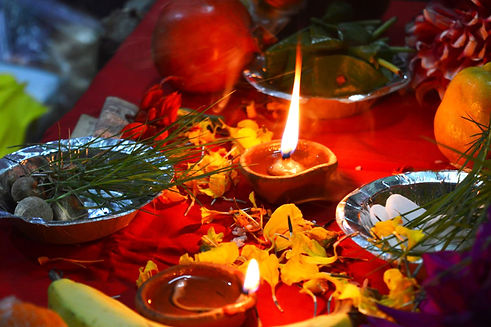Pooja & Homam Services

Rudrabhishek
‘Rudra’ is depicted as the fierce, destroying form of Lord Shiva and ‘abhishek’ means a holy bath. Therefore, Rudrabhishek Puja is a holy bath to Lord Shiva, consisting mainly of gangajal, curd, milk, honey, baelpatra, and flowers. A Rudrabhishek Pooja is said to be the easiest way to appease Lord Shiva and draw positive energies into our lives.
Durga Pooja
Durga Pooja is one of India’s grandest and most revered festivals, celebrating the triumph of Goddess Durga over the demon Mahishasura. Spanning anywhere from 6 to 10 days, the festival is marked by vibrant rituals, music, and devotion. In much of Northern India, it is observed as Navratri, with the final four days — Maha Saptami, Maha Ashtami, Maha Navami, and Vijay Dashami — holding special spiritual significance and drawing large gatherings for worship and celebration.


Maha Mrityunjaya Homam
The Maha Mrityunjaya Mantra is believed to be the most divine and powerful of all mantras. It is a powerful healing mantra that is dedicated to Lord Shiva. Mrityunjaya is another name of Lord Shiva, who helps conquer untimely or unnatural death. The Homam is performed for longevity of life and good health by priests.
Ganpati Homam
Homam, or Havan, is a holy fire ritual performed with sacred mantras and shlokas. Ganapati Homam is one such Hindu ritual dedicated to Lord Ganesha. People also perform Ganapati Puja before starting any work, business, or before entering a new home. It is considered auspicious to perform Ganapati Homam every year for a healthy and happy life


Satya Narayan Pooja
The Satyanarayanã Pooja is a religious ritual worship of the Hindu God Vishnu. The pooja involves the narration of the Satyanarayana Katha (story), which dictates the various worldly and spiritual benefits of the pooja. This Pooja is usually performed in the evening and can be performed at any suitable time, except a new-moon day and a day of eclipse.
Navgraha Pooja
Our life is influenced by the planetary system. The Navgraha Shanti Puja is performed when the positioning of one or more planets is unfavorable. A priest performs the Pooja to remove the 'Dosha' from one's natal chart. This Pooja is also performed for good health, prosperity, harmony, and success.

Diwali Pooja
Diwali is the biggest and most important festival celebrated by Indians. It symbolizes the victory of light over darkness, good over evil, and knowledge over ignorance. Goddess Lakshmi is worshipped on the night of Diwali, where people seek the goddess’ blessings for a prosperous, healthy, and wealthy life

Life Ceremonies (Sanskaras)

Mundan Ceremony
It is believed that every yoni has its influence on human birth. Shaving off the hair is considered to be a gesture of purification from previous births and freedom from the past. In Hindus, the mundan ceremony is done by a priest between four months to three years of a child's birth.
Naamkaran Sanskar
In Hindu tradition, the ceremony to name a newborn baby is referred to as Namkaran. A priest uses traditional methods and astrological rules to help families name their child for a good and healthy life. The ceremony is usually held on the 12th day of the baby’s birth, either at home or at a temple.


Annaprashana
Annaprashana is the ritual that marks the introduction of solid food to an infant’s life. This is an important milestone in a baby’s life and a pooja marks the occasion. The day of the pooja is selected by a priest, who picks an auspicious date around the time when a child is between 5-8 months old.
Dosha & Auspicious Ceremonies

Mangalik Vivah/Kumbh Vivah
According to Hindu astrology, a person born under the influence of planet Mars has Mangala Dosha. The marriage of a mangalika and a non-mangalika is considered inauspicious. It is believed that by first performing a mock marriage of the mangalika person to a tree or a kumbha, the ill-effects of the Dosha can be removed.
Kaal Sarp Dosh Pooja
Kaalsarpyog is formed when all seven planets come between Rahu and Ketu. A person born in Kaalsarpyog is believed to suffer from fears, tensions, insecurity, and financial losses. It is considered that a pooja done over a duration of 4 days by 5 priests can reduce the ill-effects of this dosha.

Bhoomi Pujan
Bhoomi Pooja is a special ritual of paying respect to the land goddess, Bhoomi Devi, and other deities before the beginning of construction of a house. People believe that this ritual brings prosperity and peace to the home. An auspicious occasion is picked by the priest to perform the pooja to seek divine blessings.








